Some wildlife photographers are so skilled that they can roll up to a location that they have never visited before and produce great images straight off the bat. But they are in the extreme minority. Most will come away with a nice set of images largely comprising portraits especially if they have never photographed the species of flora or fauna before. I call these insurance shots. They may also come away with some nice action images taken with telephoto lenses showing for example a bird in flight or a Zebra running, possibly even showing some motion. There may even be some pleasing backlit or silhouette images. But will they really come back with something completely different and special? Maybe but probably not.
This has certainly been my own experience when I visit a new destination. I’ve said it before and I’ll say it again: you really have to go back to a destination several times before you start getting different, more memorable images. When I am returning to a formerly visited destination, I try to think about the images I have taken at this location previously. I also try to look at images that other photographers have taken at the same location. I try to think about how I can take different types of images than those that are already in the market and how I can improve on my own existing images. Importantly, I try to pre-visualise different types of images. For instance, if I’ve photographed a species or a particular type of animal behavior extensively with say a telephoto lens, I try to think how I could photograph it differently. Could I photograph it from a different angle or with different lighting conditions or with a different lens? I try to force myself to think out of the box and the further I can go out of the box, the better. I really believe that pre-visualising the type of images one wants to take before actually going out to try and get them is a key method in attempting to improve one’s photography.
I have been to Midway Atoll four times already so this was my fifth trip. Although my first trip back in 2001 held the greatest number of photographic opportunities, these were the days of film and I was really just starting out photographic wise. My technical skills were at best rudimentary. This was a shame because I blew some incredible opportunities over several days of an adult White Tern feeding its chick with fish due to poor exposure technique.
On subsequent visits in the digital era I have built up a decent collection of images of the amazing birds of the atoll. On my last two visits I had become quite fixated with taking images in the early morning of Laysan Albatrosses running down the beach in order to take flight. Although among the smaller of the Albatross species, a Laysan Albatross can weigh seven pounds and have a wing span of over six feet. Unlike most birds, they cannot take flight from a standing position and instead must run for varying distances while vigorously beating their wings in order to build up sufficient momentum to become airborne. The distance that they need to run is largely a function of the strength of the headwind that they run into.
On previous visits I had taken lots of pleasing images from a distance using intermediate telephoto lenses of the birds running to take flight. I had lain on the ground to literally get a bird’s eye view of the onrushing Albatrosses and I had varied my shutter speed to make some arresting images of birds with blurred beating wings and sharp heads.
Prior to this visit, I thought about how I might photograph this behavior differently. Having used manually activated, wireless triggers to photograph large mammals up-close in East Africa using concealed, ground positioned cameras with wide-angle lenses, I wondered if I might be able to do the same with the running Albatrosses. No harm in trying I thought (like they say, if you don’t enter the lottery you won’t win the prize).
My basic thinking was this. Figure out a route that the birds were running down on a regular basis and partially bury two, zip lock covered, wireless triggered, cameras with wide-angled lenses in the sand on the route over which the birds were passing. I used rubber bands to securely fasten the opening of each bag around the lens in order to ensure that as little sand as possible would get into the bags. I cut a small hole in each bag around the viewfinder of each camera so that I could position an angle finder to the viewfinder in order to properly compose and angle each camera. Once done, I removed the angle finder and replaced it with a small spirit leveler in order to make micro adjustments to each camera’s positioning so that the horizon would not be too off kilter.
So far so good. In my first set up early one morning at the beginning of the trip, I used a 1D MK IV camera with a 15mm fish eye lens (remember this camera has a 1.3x crop factor) and a full frame 5D MK 2 camera with a 16-35mm zoom lens attached set to 16mm. I needed to preset all controls in advance. Firstly, I set the focus to manual (3ft). Knowing that I would need a very fast shutter speed I selected an ISO of 800. With light levels changing I opted to work in AV mode, dialing in +1 and 1/3 stop of +ve exposure compensation to an f.8 aperture – I figured with the birds so close to the lens that I would need some reasonable depth of field. This level of exposure compensation was a tricky choice as I was faced with broken cloud conditions and while the sun had yet to come up, it would do so in about 20 minutes. If there was full sun, I knew this would be too much +ve compensation but I figured I could accept a little over exposure.
So what happened? Firstly, the wind direction was coming from the North West meaning that the birds were running roughly parallel to the light. Not ideal. Secondly, once the sun rose, it kept ducking in and out of the clouds making for wildly different exposure conditions. Thirdly, my shutter speed never got over 1/2,000 sec – insufficient to freeze the movement of a fast moving bird so close to the lens. Fourth, neither a 15mm fish eye lens on a cropped sensor camera nor a zoom lens set to 16mm on a full frame camera was sufficiently wide to avoid clipping the wings on an Albatross 1-4 ft from the camera with its wings fully extended. Fifth, the wireless triggers were such that realistically I could only get off two frames on the MK IV body and one frame on the slower 5D MK II body as each bird ran towards the camera. Lastly and most frustratingly, although the birds pretty much ignored the partially buried cameras, they maddeningly chose different routes to take flight on all but about 10-15 occasions.
So after day one I had lots of badly exposed, unsharp, clipped wing images and zero keepers. But in one or two images I could see the potential. If I could refine my set up I knew that there was the potential to get some truly different images.
Over the next few days I gradually improved. Importantly, I switched to the use of two full frame MK 5D MK II bodies mounted with 15mm fish-eye lenses (a big thanks to tour leader Joe for the loan of one these lenses). This would optimise the chances of getting the whole of the bird with extended wings in the frame even though I knew that I would have only one frame per pass. Most importantly, I found a narrow path set between native Nalpaka bushes higher up the beach down which a steady throng of birds would take flight in the late afternoon. While I knew that I would be working with a less than ideal angled sun direction (and with the fish-eye lenses would likely include all or part of the sun in many images), light levels were much better than early in the morning. On two afternoons I had largely bright sun conditions with only a few scattered clouds so I did not have to worry too much about fluctuating light conditions and with the 5D MK 2’s reasonably low noise levels I felt comfortable pushing the ISO up to 2,500 in order to attain shutter speeds of at least 1/5,000 sec.
Off course from my hidden position behind the Nalpaka bushes, as I watched the birds run down the runway and over my cameras, there was still the small matter of pushing the wireless triggers at exactly the right moment to fully capture the birds in the frame. I ended up with many, many frames containing bits of Albatrosses although some of these are actually quite cool as shown below and could even potentially do well in photo contests.
But by persevering I ended up with about 12-15 sharp images of unclipped Albatrosses in action poses as they charged or flew towards/over my cameras. There is still room for improvement and it would be great to have full frontal lighting and less vegetation on the sides and in the background (next year’s wish list) but overall I am reasonably happy with what I came away with.
This second last image is probably my favorite – reaching for the sun might be an apt title.
Finally, this serendentipitous image was taken the split second that an Albatross, having flown in from the right, landed right in front of the camera and kicking up sand over the lens in the process.
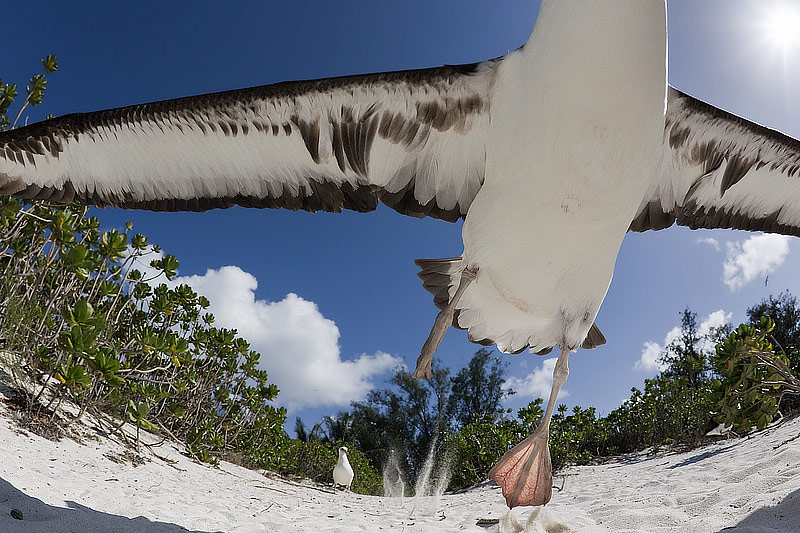
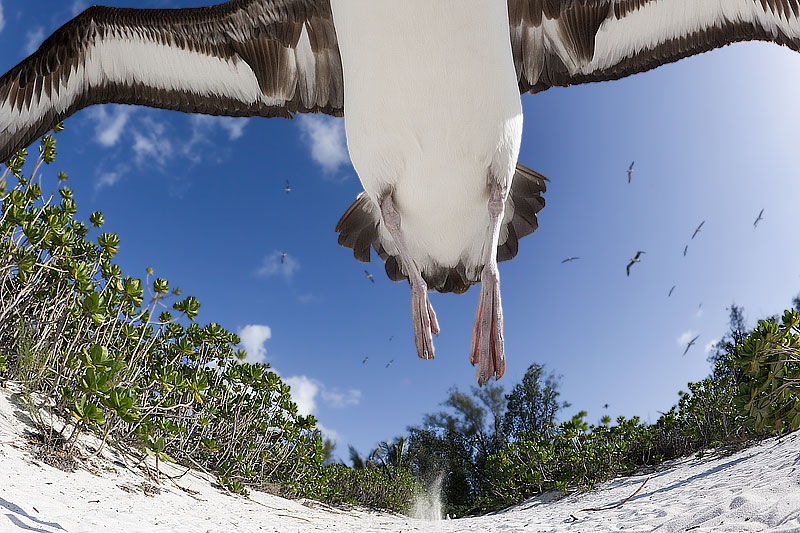
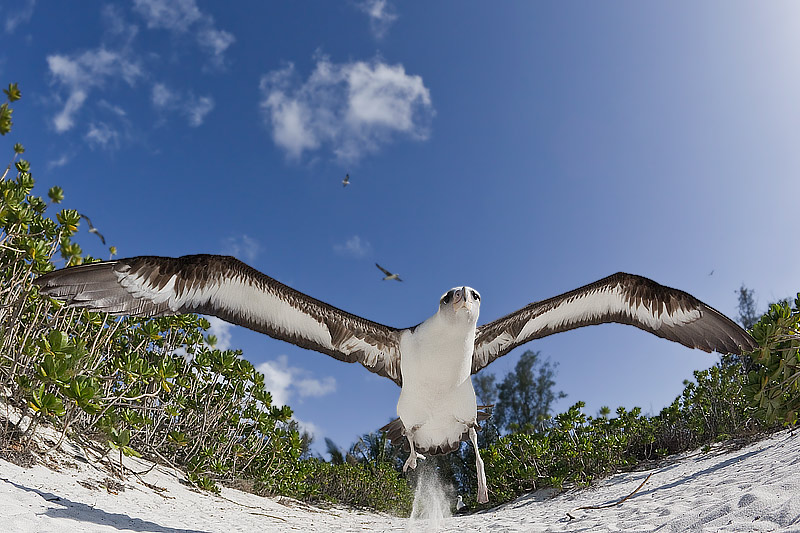
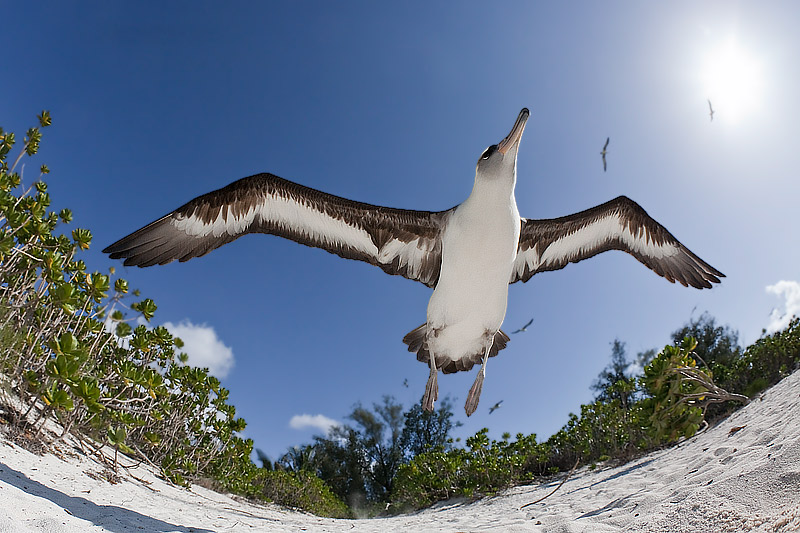
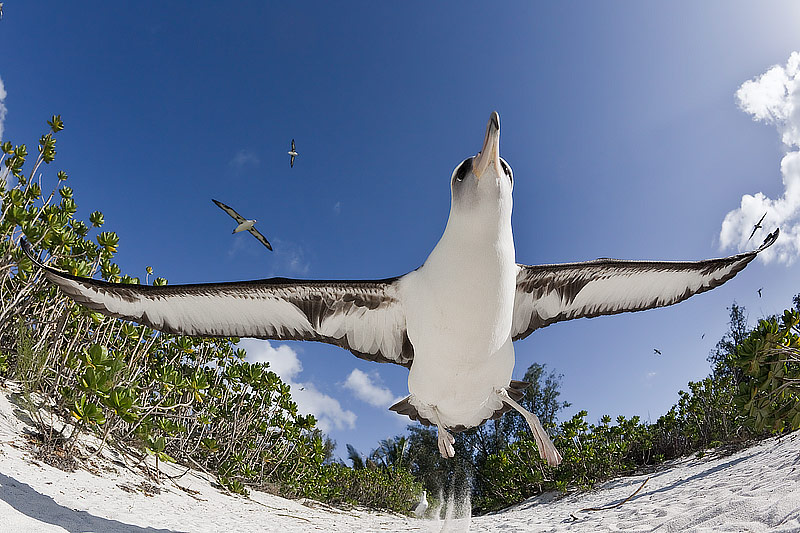
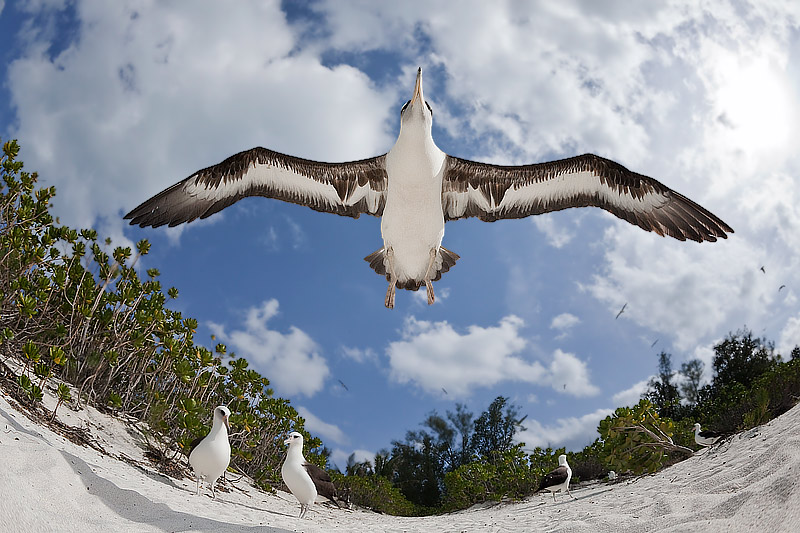
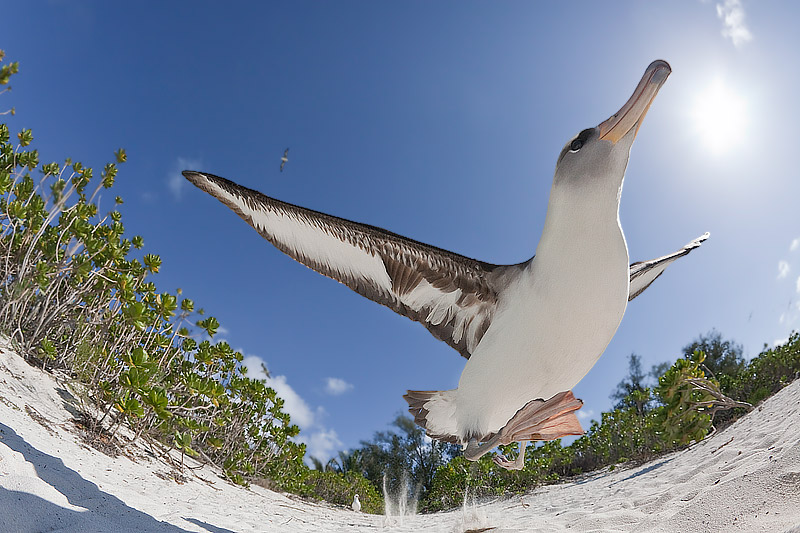
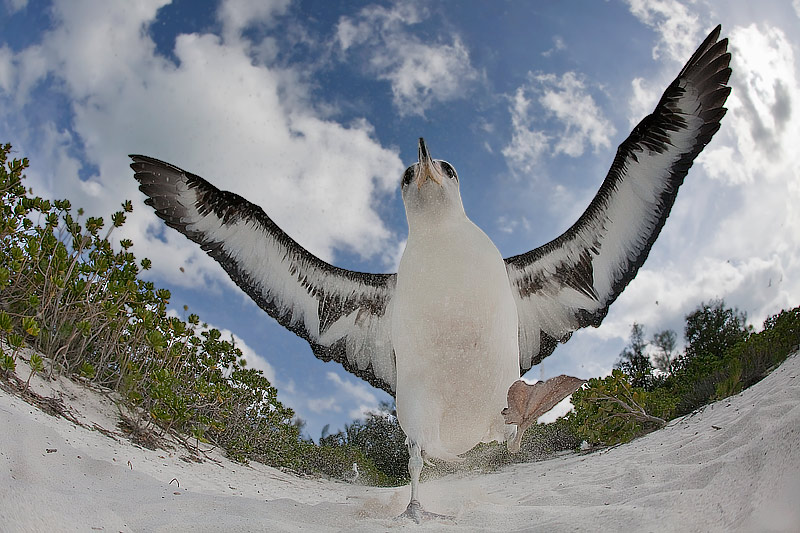
Arthur Morris
June 30, 2011
Cool and different stuff for sure. I can attest to the fact that you worked long and hard. What did you go with for exposure compensation when it was sunny? artie
Colin Stewart
June 30, 2011
Exceptional images….again, Paul! Congratulations on the results in what were clearly challenging circs. Thanks for sharing. CS
jattinn kochhar
June 30, 2011
awesome! as always
Gordon Lindsay
June 30, 2011
Great shots Paul and a good story too.
Chris Wyatt
July 1, 2011
I always look forward to geting a new story along with some exceptional images. This had the added benefit of seeing some failures to go along with the final keepers. Learning from some missed shots and how you overcame the problems was very interesting. The idea of going back to familiar places but to do something different will help me with some of my summer trips. Thanks for sharing.
Ken Dyball
July 3, 2011
Very cool images Paul, will see you in Tarangire one day
Ken Dyball…….Tanzania
Richard Vernick
July 4, 2011
Paul,
Again blown away with your different approach. I thought my pics of the these birds with the 70-200 were good, but yours are much more interesting.
Richie